[English] 日本語
 Yorodumi
Yorodumi- PDB-1f66: 2.6 A CRYSTAL STRUCTURE OF A NUCLEOSOME CORE PARTICLE CONTAINING ... -
+ Open data
Open data
- Basic information
Basic information
| Entry | Database: PDB / ID: 1f66 | ||||||
|---|---|---|---|---|---|---|---|
| Title | 2.6 A CRYSTAL STRUCTURE OF A NUCLEOSOME CORE PARTICLE CONTAINING THE VARIANT HISTONE H2A.Z | ||||||
 Components Components |
| ||||||
 Keywords Keywords |  STRUCTURAL PROTEIN/DNA / STRUCTURAL PROTEIN/DNA /  NUCLEOSOME / NUCLEOSOME /  CHROMATIN / CHROMATIN /  HISTONE / HISTONE VARIANT / PROTEIN DNA INTERACTION / HISTONE / HISTONE VARIANT / PROTEIN DNA INTERACTION /  NUCLEOPROTEIN / NUCLEOPROTEIN /  SUPERCOILED DNA / COMPLEX (NUCLEOSOME CORE-DNA) / SUPERCOILED DNA / COMPLEX (NUCLEOSOME CORE-DNA) /  STRUCTURAL PROTEIN-DNA COMPLEX STRUCTURAL PROTEIN-DNA COMPLEX | ||||||
| Function / homology |  Function and homology information Function and homology informationSUMOylation of chromatin organization proteins / Deposition of new CENPA-containing nucleosomes at the centromere / heterochromatin formation => GO:0031507 / Condensation of Prophase Chromosomes / G2/M DNA damage checkpoint / HDMs demethylate histones / Processing of DNA double-strand break ends / Nonhomologous End-Joining (NHEJ) / PRC2 methylates histones and DNA / HATs acetylate histones ...SUMOylation of chromatin organization proteins / Deposition of new CENPA-containing nucleosomes at the centromere / heterochromatin formation => GO:0031507 / Condensation of Prophase Chromosomes / G2/M DNA damage checkpoint / HDMs demethylate histones / Processing of DNA double-strand break ends / Nonhomologous End-Joining (NHEJ) / PRC2 methylates histones and DNA / HATs acetylate histones / PKMTs methylate histone lysines / Recruitment and ATM-mediated phosphorylation of repair and signaling proteins at DNA double strand breaks / RUNX1 regulates genes involved in megakaryocyte differentiation and platelet function / RMTs methylate histone arginines / Estrogen-dependent gene expression / nucleosomal DNA binding / RNA polymerase II core promoter sequence-specific DNA binding / negative regulation of megakaryocyte differentiation / protein localization to CENP-A containing chromatin /  heterochromatin / CENP-A containing nucleosome / Packaging Of Telomere Ends / Recognition and association of DNA glycosylase with site containing an affected purine / Cleavage of the damaged purine / Deposition of new CENPA-containing nucleosomes at the centromere / Recognition and association of DNA glycosylase with site containing an affected pyrimidine / Cleavage of the damaged pyrimidine / Inhibition of DNA recombination at telomere / Meiotic synapsis / RNA Polymerase I Promoter Opening / heterochromatin / CENP-A containing nucleosome / Packaging Of Telomere Ends / Recognition and association of DNA glycosylase with site containing an affected purine / Cleavage of the damaged purine / Deposition of new CENPA-containing nucleosomes at the centromere / Recognition and association of DNA glycosylase with site containing an affected pyrimidine / Cleavage of the damaged pyrimidine / Inhibition of DNA recombination at telomere / Meiotic synapsis / RNA Polymerase I Promoter Opening /  DNA methylation / Condensation of Prophase Chromosomes / ERCC6 (CSB) and EHMT2 (G9a) positively regulate rRNA expression / SIRT1 negatively regulates rRNA expression / PRC2 methylates histones and DNA / cellular response to estradiol stimulus / RNA Polymerase I Promoter Escape / Transcriptional regulation by small RNAs / Formation of the beta-catenin:TCF transactivating complex / DNA methylation / Condensation of Prophase Chromosomes / ERCC6 (CSB) and EHMT2 (G9a) positively regulate rRNA expression / SIRT1 negatively regulates rRNA expression / PRC2 methylates histones and DNA / cellular response to estradiol stimulus / RNA Polymerase I Promoter Escape / Transcriptional regulation by small RNAs / Formation of the beta-catenin:TCF transactivating complex /  euchromatin / RUNX1 regulates genes involved in megakaryocyte differentiation and platelet function / Activated PKN1 stimulates transcription of AR (androgen receptor) regulated genes KLK2 and KLK3 / NoRC negatively regulates rRNA expression / B-WICH complex positively regulates rRNA expression / DNA Damage/Telomere Stress Induced Senescence / chromatin DNA binding / RMTs methylate histone arginines / euchromatin / RUNX1 regulates genes involved in megakaryocyte differentiation and platelet function / Activated PKN1 stimulates transcription of AR (androgen receptor) regulated genes KLK2 and KLK3 / NoRC negatively regulates rRNA expression / B-WICH complex positively regulates rRNA expression / DNA Damage/Telomere Stress Induced Senescence / chromatin DNA binding / RMTs methylate histone arginines /  Meiotic recombination / Pre-NOTCH Transcription and Translation / Meiotic recombination / Pre-NOTCH Transcription and Translation /  nucleosome assembly / Activation of anterior HOX genes in hindbrain development during early embryogenesis / Transcriptional regulation of granulopoiesis / structural constituent of chromatin / nucleosome assembly / Activation of anterior HOX genes in hindbrain development during early embryogenesis / Transcriptional regulation of granulopoiesis / structural constituent of chromatin /  nucleosome / RUNX1 regulates transcription of genes involved in differentiation of HSCs / chromatin organization / Senescence-Associated Secretory Phenotype (SASP) / Oxidative Stress Induced Senescence / Estrogen-dependent gene expression / RNA polymerase II cis-regulatory region sequence-specific DNA binding / Amyloid fiber formation / protein heterodimerization activity / positive regulation of transcription by RNA polymerase II / protein-containing complex / nucleosome / RUNX1 regulates transcription of genes involved in differentiation of HSCs / chromatin organization / Senescence-Associated Secretory Phenotype (SASP) / Oxidative Stress Induced Senescence / Estrogen-dependent gene expression / RNA polymerase II cis-regulatory region sequence-specific DNA binding / Amyloid fiber formation / protein heterodimerization activity / positive regulation of transcription by RNA polymerase II / protein-containing complex /  DNA binding / extracellular exosome / DNA binding / extracellular exosome /  nucleoplasm / nucleoplasm /  nucleus nucleusSimilarity search - Function | ||||||
| Biological species |  Xenopus laevis (African clawed frog) Xenopus laevis (African clawed frog)  Mus musculus (house mouse) Mus musculus (house mouse)  Homo sapiens (human) Homo sapiens (human) | ||||||
| Method |  X-RAY DIFFRACTION / X-RAY DIFFRACTION /  SYNCHROTRON / Resolution: 2.6 Å SYNCHROTRON / Resolution: 2.6 Å | ||||||
 Authors Authors | Suto, R.K. / Clarkson, M.J. / Tremethick, D.J. / Luger, K. | ||||||
 Citation Citation |  Journal: Nat.Struct.Biol. / Year: 2000 Journal: Nat.Struct.Biol. / Year: 2000Title: Crystal structure of a nucleosome core particle containing the variant histone H2A.Z. Authors: Suto, R.K. / Clarkson, M.J. / Tremethick, D.J. / Luger, K. | ||||||
| History |
|
- Structure visualization
Structure visualization
| Structure viewer | Molecule:  Molmil Molmil Jmol/JSmol Jmol/JSmol |
|---|
- Downloads & links
Downloads & links
- Download
Download
| PDBx/mmCIF format |  1f66.cif.gz 1f66.cif.gz | 334.6 KB | Display |  PDBx/mmCIF format PDBx/mmCIF format |
|---|---|---|---|---|
| PDB format |  pdb1f66.ent.gz pdb1f66.ent.gz | 252.1 KB | Display |  PDB format PDB format |
| PDBx/mmJSON format |  1f66.json.gz 1f66.json.gz | Tree view |  PDBx/mmJSON format PDBx/mmJSON format | |
| Others |  Other downloads Other downloads |
-Validation report
| Arichive directory |  https://data.pdbj.org/pub/pdb/validation_reports/f6/1f66 https://data.pdbj.org/pub/pdb/validation_reports/f6/1f66 ftp://data.pdbj.org/pub/pdb/validation_reports/f6/1f66 ftp://data.pdbj.org/pub/pdb/validation_reports/f6/1f66 | HTTPS FTP |
|---|
-Related structure data
| Related structure data | |
|---|---|
| Similar structure data |
- Links
Links
- Assembly
Assembly
| Deposited unit | 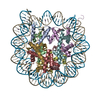
| ||||||||||
|---|---|---|---|---|---|---|---|---|---|---|---|
| 1 |
| ||||||||||
| Unit cell |
|
- Components
Components
-DNA chain , 1 types, 2 molecules IJ
| #1: DNA chain | Mass: 45054.844 Da / Num. of mol.: 2 / Source method: obtained synthetically |
|---|
-Protein , 4 types, 8 molecules AEBFCGDH
| #2: Protein |  Mass: 15507.190 Da / Num. of mol.: 2 Source method: isolated from a genetically manipulated source Source: (gene. exp.)  Xenopus laevis (African clawed frog) / Plasmid: PET / Production host: Xenopus laevis (African clawed frog) / Plasmid: PET / Production host:   Escherichia coli (E. coli) / References: UniProt: Q7ZT64, UniProt: P84233*PLUS Escherichia coli (E. coli) / References: UniProt: Q7ZT64, UniProt: P84233*PLUS#3: Protein |  Mass: 11394.426 Da / Num. of mol.: 2 Source method: isolated from a genetically manipulated source Source: (gene. exp.)   Mus musculus (house mouse) / Plasmid: PET / Production host: Mus musculus (house mouse) / Plasmid: PET / Production host:   Escherichia coli (E. coli) / References: UniProt: P62806 Escherichia coli (E. coli) / References: UniProt: P62806#4: Protein |  Mass: 13581.796 Da / Num. of mol.: 2 Source method: isolated from a genetically manipulated source Source: (gene. exp.)   Homo sapiens (human) / Plasmid: PUC / Production host: Homo sapiens (human) / Plasmid: PUC / Production host:   Escherichia coli (E. coli) / References: UniProt: P17317, UniProt: P0C0S5*PLUS Escherichia coli (E. coli) / References: UniProt: P17317, UniProt: P0C0S5*PLUS#5: Protein |  Mass: 13979.291 Da / Num. of mol.: 2 Source method: isolated from a genetically manipulated source Source: (gene. exp.)  Xenopus laevis (African clawed frog) / Plasmid: PET / Production host: Xenopus laevis (African clawed frog) / Plasmid: PET / Production host:   Escherichia coli (E. coli) / References: UniProt: P02281 Escherichia coli (E. coli) / References: UniProt: P02281 |
|---|
-Non-polymers , 2 types, 340 molecules 


| #6: Chemical | ChemComp-MN / #7: Water | ChemComp-HOH / |  Water Water |
|---|
-Experimental details
-Experiment
| Experiment | Method:  X-RAY DIFFRACTION / Number of used crystals: 3 X-RAY DIFFRACTION / Number of used crystals: 3 |
|---|
- Sample preparation
Sample preparation
| Crystal |
| ||||||||||||||||||||||||||||||||||||||||||||||||
|---|---|---|---|---|---|---|---|---|---|---|---|---|---|---|---|---|---|---|---|---|---|---|---|---|---|---|---|---|---|---|---|---|---|---|---|---|---|---|---|---|---|---|---|---|---|---|---|---|---|
Crystal grow |
| ||||||||||||||||||||||||||||||||||||||||||||||||
| Components of the solutions |
| ||||||||||||||||||||||||||||||||||||||||||||||||
| Crystal grow | *PLUS Method: vapor diffusion / Details: used macroseeding | ||||||||||||||||||||||||||||||||||||||||||||||||
| Components of the solutions | *PLUS
|
-Data collection
| Diffraction |
| ||||||||||||||||||||
|---|---|---|---|---|---|---|---|---|---|---|---|---|---|---|---|---|---|---|---|---|---|
| Diffraction source |
| ||||||||||||||||||||
| Detector |
| ||||||||||||||||||||
| Radiation | Protocol: SINGLE WAVELENGTH / Monochromatic (M) / Laue (L): M / Scattering type: x-ray | ||||||||||||||||||||
| Radiation wavelength |
| ||||||||||||||||||||
| Reflection | Resolution: 2.6→25 Å / Num. all: 66416 / Num. obs: 65959 / % possible obs: 99.6 % / Observed criterion σ(F): 0 / Observed criterion σ(I): 0 / Redundancy: 4.3 % / Rmerge(I) obs: 0.112 / Net I/σ(I): 7.7 | ||||||||||||||||||||
| Reflection shell | Resolution: 2.6→2.64 Å / Redundancy: 3 % / Rmerge(I) obs: 0.245 / Num. unique all: 3292 / % possible all: 99.9 | ||||||||||||||||||||
| Reflection shell | *PLUS % possible obs: 99.9 % |
- Processing
Processing
| Software |
| |||||||||||||||||||||||||
|---|---|---|---|---|---|---|---|---|---|---|---|---|---|---|---|---|---|---|---|---|---|---|---|---|---|---|
| Refinement | Resolution: 2.6→25 Å / Cross valid method: THROUGHOUT / σ(F): 0 / σ(I): 0 / Stereochemistry target values: Engh & Huber
| |||||||||||||||||||||||||
| Displacement parameters |
| |||||||||||||||||||||||||
| Refinement step | Cycle: LAST / Resolution: 2.6→25 Å
| |||||||||||||||||||||||||
| Refine LS restraints |
| |||||||||||||||||||||||||
| Software | *PLUS Name: CNS / Classification: refinement | |||||||||||||||||||||||||
| Refinement | *PLUS Highest resolution: 2.6 Å / Lowest resolution: 25 Å / % reflection Rfree: 3.1 % / Rfactor obs: 0.193 | |||||||||||||||||||||||||
| Solvent computation | *PLUS | |||||||||||||||||||||||||
| Displacement parameters | *PLUS | |||||||||||||||||||||||||
| Refine LS restraints | *PLUS
|
 Movie
Movie Controller
Controller



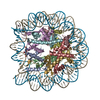
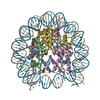
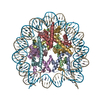
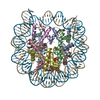
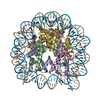
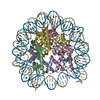
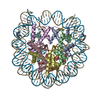
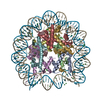
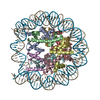
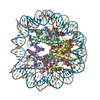
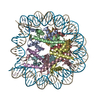
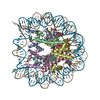
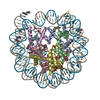
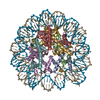
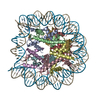
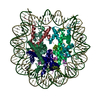
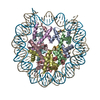
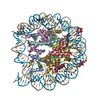

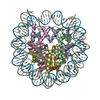
 PDBj
PDBj












































